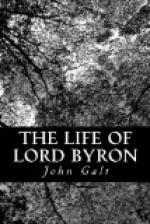At this period my fellow-passengers were full of their adventures in Albania. The country was new, and the inhabitants had appeared to them a bold and singular race. In addition to the characteristic descriptions which I have extracted from Lord Byron’s notes, as well as Mr Hobhouse’s travels, I am indebted to them, as well as to others, for a number of memoranda obtained in conversation, which they have themselves neglected to record, but which probably became unconsciously mingled with the recollections of both; at least, I can discern traces of them in different parts of the poet’s works.
The Albanians are a race of mountaineers, and it has been often remarked that mountaineers, more than any other people, are attached to their native land, while no other have so strong a thirst of adventure. The affection which they cherish for the scenes of their youth tends, perhaps, to excite their migratory spirit. For the motive of their adventures is to procure the means of subsisting in ease at home.
This migratory humour is not, however, universal to the Albanians, but applies only to those who go in quest of rural employment, and who are found in a state of servitude among even the Greeks. It deserves, however, to be noticed, that with the Greeks they rarely ever mix or intermarry, and that they retain both their own national dress and manners unchanged among them. Several of their customs are singular. It is, for example, in vain to ask a light or any fire from the houses of the Albanians after sunset, if the husband or head of the family be still afield; a custom in which there is more of police regulation than of superstition, as it interdicts a plausible pretext for entering the cottages in the obscurity of twilight, when the women are defenceless by the absence of the men.
Some of their usages, with respect to births, baptisms, and burials, are also curious. When the mother feels the fulness of time at hand, the priestess of Lucina, the midwife, is duly summoned, and she comes bearing in her hand a tripod, better known as a three-legged stool, the uses of which are only revealed to the initiated. She is received by the matronly friends of the mother, and begins the mysteries by opening every lock and lid in the house. During this ceremony the maiden females are excluded.
The rites which succeed the baptism of a child are still more recondite. Four or five days after the christening, the midwife prepares, with her own mystical hands, certain savoury messes, spreads a table, and places them on it. She then departs, and all the family, leaving the door open, in silence retire to sleep. This table is covered for the Miri of the child, an occult being, that is supposed to have the care of its destiny. In the course of the night, if the child is to be fortunate, the Miri comes and partakes of the feast, generally in the shape of a cat; but if the Miri do not come, nor taste of the food, the child is considered to have been doomed to misfortune and misery; and no doubt the treatment it afterwards receives is consonant to its evil predestination.




